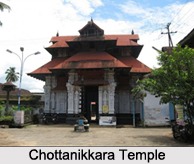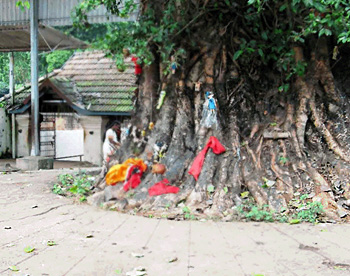 The main deity at Chottanikara temple in Kerala is worshipped as Rajarajeswari. The most unique sight at Chottanikara temple is that the possessed is being exorcised in large numbers. This takes place at noon worship particularly on Fridays. The custom is that the possessed offer prayers before the deity, their hearts throbbing with ecstasy. Amidst the beating of the drums and the chanting of "Amme (Divine Mother) and Narayana" they shriek and dance. Often a tussle ensues between the Devi and the evil spirits in which it is the latter which admit defeat and depart.
The main deity at Chottanikara temple in Kerala is worshipped as Rajarajeswari. The most unique sight at Chottanikara temple is that the possessed is being exorcised in large numbers. This takes place at noon worship particularly on Fridays. The custom is that the possessed offer prayers before the deity, their hearts throbbing with ecstasy. Amidst the beating of the drums and the chanting of "Amme (Divine Mother) and Narayana" they shriek and dance. Often a tussle ensues between the Devi and the evil spirits in which it is the latter which admit defeat and depart.
Deity of Chhotanikara Temple
The deity is worshipped in three different forms-as Goddess Saraswati in the morning clothed in an impeccable white garment, as Bhadrakali at noon with crimson red cloth and as Goddess Durga in the evening wearing a bright blue dress. It is because of these threefold aspects of Saraswati, Bhadrakali and Durga that she is worshipped as Rajarajeswari.
The vigraha which faces east is of laterite, three or four foot high and is said to be self-born. It has no well-defined shape. It can be seen only in the morning when the nirmlysm (previous day`s flowers, garlands etc.) is removed. At other times, it is covered with beautiful golden raiment about four or five feet high. This idol has four arms-`the upper right holds the disc, the upper left bears the conch, the lower right hand is held in a boon-conferring pose and the lower left indicates the Abhaya Mudra or fearlessness pose. Indeed the golden-hued idol bedecked with flowers, garlands and jewels and bathed in a myriad lights kept in front shines resplendently. It is a picturesque image bewitching everybody, an embodiment of peace, dispelling fear from devotees who bow before Her.
 Alongside the Devi, to her right, is another image of Lord Vishnu in granite. This is about two feet high springing from the same pedestal. They together are called Lakshminarayana. Hence the popular chant of the devotees, Amme (Mother) Narayana, Devi Narayana, Lakshmi Narayana, etc.
Alongside the Devi, to her right, is another image of Lord Vishnu in granite. This is about two feet high springing from the same pedestal. They together are called Lakshminarayana. Hence the popular chant of the devotees, Amme (Mother) Narayana, Devi Narayana, Lakshmi Narayana, etc.
A feature of the deity is that it is not fixed with asthabandha as is the case in most of the temples. Hence the area around the pedestal is full of loose sand. Because of this the water poured on the deity does not flow out through the pipe outside (generally fixed to the north) but percolates underground. It is believed that water flows underground and joins the tirtha of the Onakkur Bhagawati temple, one and half furlongs away.
On the north-east side of the main deity is the Dharma Sasta shrine. Here he is depicted not as Brahmachari as is generally the case but as a grihastha with his two wives, Purna and Pushkala. The vigraha of Sastha is also of granite, about half a foot high with golden covering.
Architecture of Chhottanikara Temple
Outside the nalambalam in front of the shrine there is the usual flagstaff, altar (balikallu), anapandal (pandal for elephants) etc. On the south, somewhat in the middle, there is a platform called pavizhamallithara where the Devi is supposed to have made her first appearance. On the south-west there is a Lord Shiva shrine in the form of Nagadevata and Yakshi
Outside the main temple on the north-east there is a flight of stone-steps which leads to the famed Kizh-kavu, the abode of Bhadrakali mentioned earlier. This is also a one-foot granite image facing west clothed in the raiment made of panchaloha. This is said to have been installed by Vilvamangalam Swamiyar who had retrieved it from inside the tank in front of the shrine. A landmark here which cannot be missed is of course the paala tree described earlier, with hundreds of nails driven into its trunk.
Festivals of Chhotanikara Temple
The annual festival of the temple comes in Kumbha (I ebruary-March). It lasts for nine days starting with the hoisting on Rohini Nakshatra and ending on Uttram tiny a special feature is the daily arattu during the festival, not on the last day as in other temples.
During the festival, darshan on the Makham day is very auspicious and attracts a vast concourse of pilgrims especially between 2 P.M. and 5 P.M., the period considered most efficacious. Women pray for married bliss and for the prosperity of their children. Others pray for achieving their desired objects. The deity is specially decorated for the occasion with gold and diamonds shines in all its splendour. It is believed that the goddess gave darshan to Vilwa-mangafam Swamiyar on this day and appears in the same form to her innumerable devotees.











